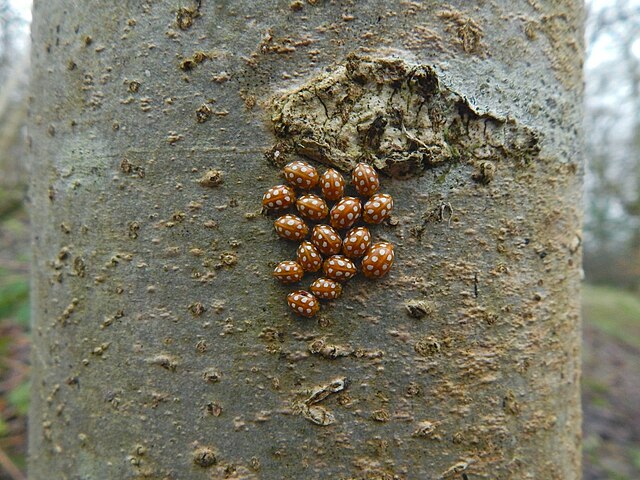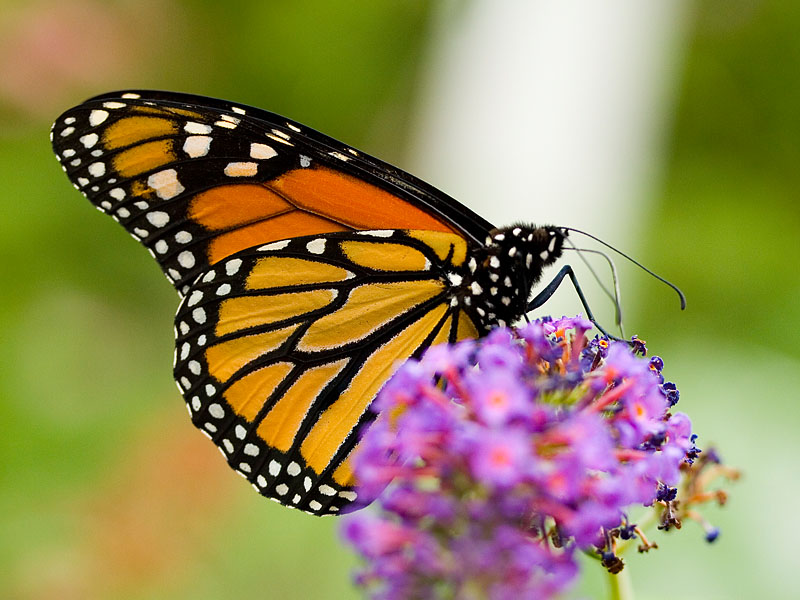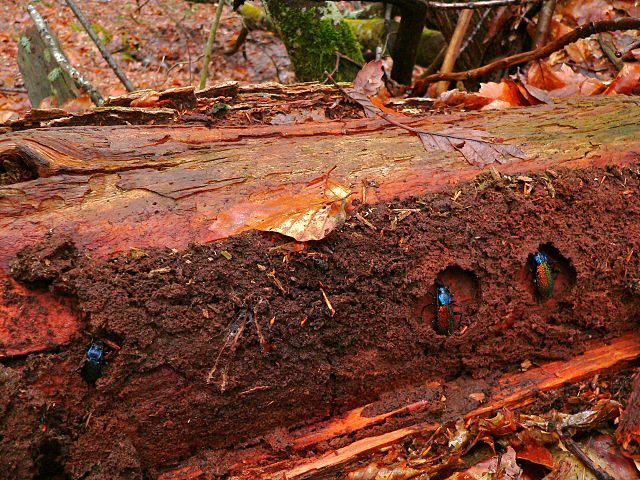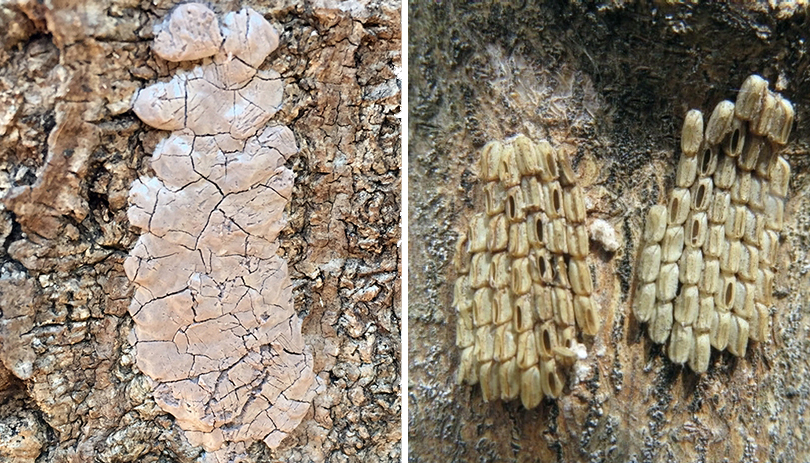WHAT DO INSECTS DO IN THE WINTER?
While we’re hunkered down indoors during the wintertime, one might be wondering where all the insects have gone. With summer having come and gone in a flash, it’s hard to erase our memories of all those bug-filled summer days. Well, our insects friends and foes all have different strategies for withstanding the cold temperatures.
Insects strategies are more similar to plants than they are to animal strategies for surviving freezing temperatures. There are a wide range of strategies and it varies species to species, so this is an attempt to distill a very complicated topic. In some cases, it is important to understand the overwintering strategies of orchard insects pests (see ‘Shelter in Place’ section below) in order to apply appropriate measures to manage them!

Source: Wikimedia Commons
DIFFERENT STRATEGIES
Migratory
Some insects choose to migrate to warmer temperatures, similar to what certain birds do. A good example is the Monarch butterfly, which each year flies down to Mexico for the winter months. Other migratory insects live most of the year in warmer climates and migrate to temperate climates in the summer. Many species of dragonflies, butterflies, and moths are migratory, as well as some species of leafhoppers and grasshoppers.

Shelter in Place
Insects are ectothermic, meaning they cannot generate their own body heat; so for those that can’t migrate to warmer climates, winter presents some unique challenges. However, insects have developed different strategies for surviving the cold. Some insects choose to take shelter in our homes, in the soil, or within plant/wood debris during the winter. The ones that stay outdoors during the winter often have special adapations that allow them to survive the cold. Some do this by producing an antifreeze-like substance in their bodies. There are many other adaptations that allow these shelter-in-place insects to survive the winter. These shelter-in-place insects survive the winter by living in the soil, leaf litter, tree cavities, and plant/wood debris They may do this as an adult, larvae, egg or pupa. Many of these insects minimize their activity and body functions, almost like hibernation. The ones that have fewer adaptations for withstanding colder temperatures often reside in our homes. These are the insects that cause problems in orchards the following spring.

Source: Wikimedia Commons
The sheltering habits of some orchard pest insects are relevant to their management:
- Some insect pests, including codling moth, spotted lanternfly, aphids, and scale, may overwinter as pupae or eggs on the trunk and limbs of a tree. Applying a dormant oil spray can be effective to smother them and reduce or prevent their emergence in spring. Scraping off loose bark can also help eliminate some of their preferred locations to overwinter. In the case of spotted lanternfly, the egg masses themselves are easy to identify and scrape off!
- Some of the most challenging orchard pests, like peach tee borer, oriental fruit moth, codling moth, and plum curculio may overwinter in the soil or leaf litter under fruit trees. Chickens and other poultry can be really effective allies in finding and eating these pests when allowed into the orchard in late fall or before insect emergence in spring. Where chickens aren’t an option, it can also be effective to cultivate the top several inches of soil around the base of fruit trees to kill some of the overwintering insects. Another potential control option for insect pests who overwinter in soil is spraying beneficial nematodes to parisitize them.

ADAPTATIONS
For the insects that stick around and don’t migrate to warmer temperatures, they often have adaptions that allow them to withstand the cold. Two main strategies have evolved for insects to survive extreme conditions: freeze avoidance and freeze tolerance.
Freeze avoidant insects cannot tolerate internal ice formation, so they avoid freezing in various ways. Many of them depress the temperature at which their body fluids freeze. They keep their body fluids liquid, despite the low temperature. Ice forms in the extracellular areas of their bodies, but not inside the cells themselves. Some enter a “dry” hibernation by getting rid of all the food and water in their body. This prevents any freezing from occurring since there is no moisture within the insect that can crystallize. Other insects have a waxy coating on the exoskeleton that protects against ice formation on the body. Some species have antifreeze proteins in their blood that lower the freezing temperature of the body, avoid freezing altogether. Additionally, some insects avoid the freezing temperatures by living under leaves or in the soil. They do better with snow cover, which can insulate their hiding places, and when temperatures are stable as opposed to fluctuating. It is also important to note that windchill does not impact insects, so it feels a little warmer for the bugs than it does for humans right now. Most freeze avoidant insects live in the northern hemisphere with long winters. Spiders and mites are examples of freeze avoidant insects.
Freeze tolerance in insects refers to the ability of some species to survive ice formation within their tissues. This is a process that requires them to freeze half of their body and cut down on metabolic processes by going through a hibernation period. They will basically convert 50 percent or more of its body water to ice. These insects have an advantage to freeze avoidant insects: they can emerge earlier in the season, as soon as spring temperatures arrive, avoiding potential predation and having a jumpstart on the breeding season. Most freeze tolerant insects live in the southern hemisphere with more infrequent cold snaps. An example of a freeze-tolerant insect is the woolly bear.
CONCLUSION
No matter the strategy, all insects will eventually die if it gets cold enough. However, each species has a different tolerance to cold temperatures, so the lethal temperature varies between different species. Climate change may affect what insect pests are relevant in our region, and how many generations of them we experience per season!
SOURCES
Organic Gardener’s Handbook of Natural Pest and Disease Control, Ellis & Bradley
https://www.missoulabutterflyhouse.org/insect-winter-ecology-freeze-avoidance/
http://www.kenstoreylab.com/research/freeze-avoidance-2/
https://www.creaturecontrol.com/blog/the-insect-freeze-tolerance-mechanism/
https://arthropodecology.com/2016/01/05/frozen-spiders/
https://www.fs.usda.gov/wildflowers/pollinators/Monarch_Butterfly/migration/index.shtml
https://www.si.edu/spotlight/buginfo/winter
https://www.texasento.net/migration.htm
DISCLAIMER
The information presented on this website is for informational, reference, and educational purposes only and should not be interpreted as a substitute for diagnosis and treatment by a health care professional. Always consult a healthcare professional or medical doctor when suffering from any health ailment, disease, illness, or injury, or before attempting any traditional or folk remedies. Keep all plants away from children. As with any natural product, they can be toxic if misused.
This POP Blog was written by Orchard Assistant Simone Shemshedini with help from Co-Executive Director Phil Forsyth.
SUPPORT US! If you found this entry useful, informative, or inspiring, please consider a donation of any size to help POP in planting and supporting community orchards in Philadelphia: phillyorchards.org/donate